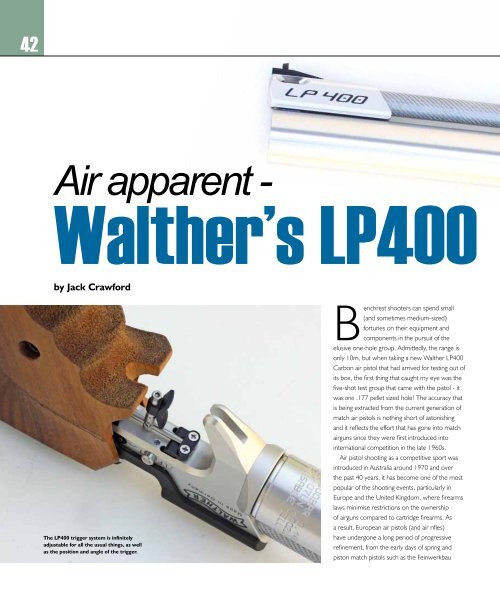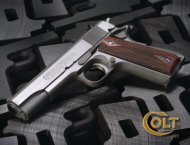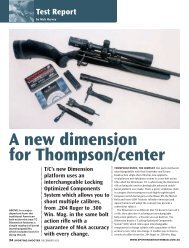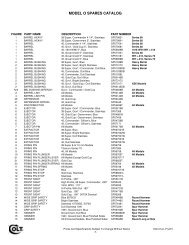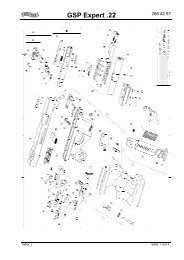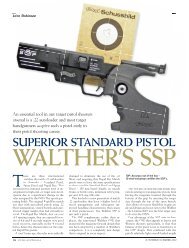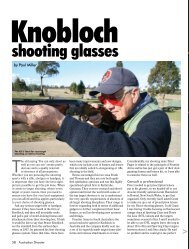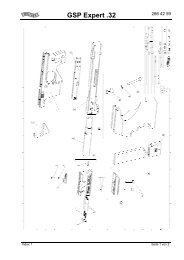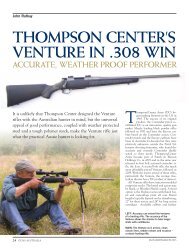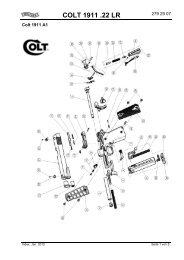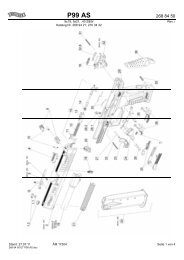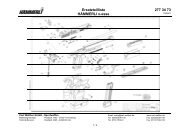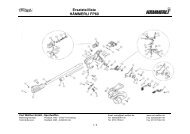Air apparent - Walther's LP400 Carbon - Frontier Arms
Air apparent - Walther's LP400 Carbon - Frontier Arms
Air apparent - Walther's LP400 Carbon - Frontier Arms
You also want an ePaper? Increase the reach of your titles
YUMPU automatically turns print PDFs into web optimized ePapers that Google loves.
42<br />
<strong>Air</strong> <strong>apparent</strong> -<br />
Walther’s <strong>LP400</strong><br />
by Jack Crawford<br />
The <strong>LP400</strong> trigger system is infinitely<br />
adjustable for all the usual things, as well<br />
as the position and angle of the trigger.<br />
Benchrest shooters can spend small<br />
(and sometimes medium-sized)<br />
fortunes on their equipment and<br />
components in the pursuit of the<br />
elusive one-hole group. Admittedly, the range is<br />
only 10m, but when taking a new Walther <strong>LP400</strong><br />
<strong>Carbon</strong> air pistol that had arrived for testing out of<br />
its box, the first thing that caught my eye was the<br />
five-shot test group that came with the pistol - it<br />
was one .177 pellet sized hole! The accuracy that<br />
is being extracted from the current generation of<br />
match air pistols is nothing short of astonishing<br />
and it reflects the effort that has gone into match<br />
airguns since they were first introduced into<br />
international competition in the late 1960s.<br />
<strong>Air</strong> pistol shooting as a competitive sport was<br />
introduced in Australia around 1970 and over<br />
the past 40 years, it has become one of the most<br />
popular of the shooting events, particularly in<br />
Europe and the United Kingdom, where firearms<br />
laws minimise restrictions on the ownership<br />
of airguns compared to cartridge firearms. As<br />
a result, European air pistols (and air rifles)<br />
have undergone a long period of progressive<br />
refinement, from the early days of spring and<br />
piston match pistols such as the Feinwerkbau
43<br />
<strong>Carbon</strong><br />
The Walther <strong>LP400</strong> <strong>Carbon</strong><br />
is designed to be lighter than<br />
the standard aluminiumshrouded<br />
<strong>LP400</strong>s. Accuracy<br />
is not compromised by the<br />
lighter barrel.<br />
Model 65 to the carbon-dioxide-powered pistols<br />
to the current crop of high-pressure compressed<br />
air match pistols.<br />
The complex and wonderfully engineered<br />
Feinwerkbau spring and piston system was<br />
superseded by carbon dioxide power to<br />
minimise recoil, reduce loading effort and simplify<br />
manufacture. The move from carbon-dioxide<br />
to compressed air is again a move to improve<br />
performance and get around the variations<br />
inherent in carbon dioxide propulsion - namely<br />
the variations in gas pressure with temperature<br />
and the greater mass of the carbon-dioxide<br />
compared to compressed air that makes a slight<br />
but significant contribution to recoil.<br />
If all target pistol shooters put some range time<br />
in with a match air pistol, their mastering of the<br />
art of target pistol shooting would come a lot<br />
more quickly than if they started out blazing away<br />
with a .38 Super self-loader at targets the size of<br />
dinner plates.<br />
Not a carbon copy<br />
The Walther <strong>LP400</strong> <strong>Carbon</strong> is one of the<br />
company’s ‘Ready for London’ (Olympic Games,<br />
that is) models that have been recently introduced.<br />
The model complements the LP300<br />
series of already high-tech match air<br />
pistols produced by Walther. The<br />
most obvious feature of the new<br />
pistol is the barrel. Instead of the<br />
conventional steel tube or aluminium<br />
housing, the test pistol was fitted with the<br />
‘carbon’ option - a carbon-fibre barrel jacket that<br />
encases a steel inner tube. The barrel jacket would<br />
do justice as a piece of jewellery with what appears<br />
to be a spiral of stainless steel wire wound around<br />
the barrel encased in a clear polymer sleeve!<br />
The use of carbon fibre in Walther firearms<br />
is not new, so the company has had some<br />
experience in that area and I surmise that the<br />
use of carbon-fibre sleeves in its airguns’ barrels<br />
is a way of reducing upfront and overall weight,<br />
while using a material that has acknowledged<br />
vibration damping characteristics. Walther still<br />
uses standard (aluminium shrouded) barrels in its<br />
standard <strong>LP400</strong>s and they are identical in every<br />
other respect to the <strong>Carbon</strong> models. The big<br />
difference, however, is in their weight; the <strong>LP400</strong><br />
<strong>Carbon</strong> weighs 870g, while the standard model<br />
weighs 950g, with all the additional weight<br />
being in the front end of the pistol.<br />
><br />
The test group supplied with the <strong>LP400</strong> is the same<br />
size as a 4.5mm pellet, which is a zero group at 10m.
44<br />
<strong>Air</strong> <strong>apparent</strong> - Walther’s <strong>LP400</strong> <strong>Carbon</strong><br />
The rear-sight is fully adjustable<br />
for everything, including the width<br />
and depth of the rear-sight notch.<br />
The ISSF <strong>Air</strong> Pistol match is a gruelling one,<br />
requiring 60 scoring shots plus sighters to be<br />
fired in the Open section of the match. The<br />
10-ring is only 10mm in diameter, so it is timeconsuming<br />
to execute that many precision shots<br />
where the shooting arm needs to be held up<br />
for an average of 10 seconds per shot. On the<br />
other hand, if the pistol is too light, it is likely<br />
to be less stable and more easily affected by<br />
small movements associated with the shooter’s<br />
physiology and the functioning of the pistol’s<br />
mechanism. The Walther <strong>LP400</strong> <strong>Carbon</strong> has<br />
addressed these issues in its design of the<br />
<strong>LP400</strong>’s dynamics and operation. The Vario<br />
trigger system, for example, is ball bearing<br />
mounted and attached as close to the barrel<br />
axis as possible, so that torque on the pistol<br />
that exerts downward pressure at the muzzle<br />
is minimised when pressure is applied to the<br />
trigger. The trigger is naturally fully adjustable<br />
for distance, angle, release weight, take-up and<br />
backlash.<br />
The <strong>LP400</strong> <strong>Carbon</strong> has an aluminium muzzle<br />
sleeve that carries the front-sight and muzzle<br />
brake arrangement. Dovetail grooves down<br />
each side of the sight accommodate two sliding<br />
barrel weights. While these weights only weigh<br />
14g each, their location right at the front of<br />
the barrel increases their effectiveness without<br />
significantly increasing the weight of the pistol.<br />
The test pistol came with a set of large<br />
adjustable orthopaedic right-hand grips, but<br />
they proved a little large for my average-sized<br />
hand. There are six grip sizes available for<br />
right-handers and three sizes for left-handers.<br />
The grip frame on the <strong>LP400</strong> <strong>Carbon</strong> has<br />
been designed to accommodate smaller than<br />
average grips if required for young or female<br />
shooters. There is also an <strong>LP400</strong> Compact<br />
<strong>Carbon</strong> model, which is shorter (375mm versus<br />
410mm) and lighter (850g versus 870g) than<br />
the standard <strong>Carbon</strong>.<br />
The grips can be adjusted for rake and cant, as<br />
well as having an adjustable palm rest. Walther<br />
uses a system called Memory-Effect with these<br />
grips, which allows the grips to be removed from<br />
the gun for cleaning or adjustment without losing<br />
their original setting.<br />
The <strong>LP400</strong> <strong>Carbon</strong>’s sights are adjustable<br />
for the usual windage and elevation, but the<br />
pistol also has a rear-sight notch adjustment for<br />
both width and depth. These latter features are<br />
important on airguns that are usually shot indoors<br />
under artificial light, as the ability to tune the sights<br />
to the lighting conditions is critical in competition.<br />
The rear-sight assembly is quite large and this<br />
allows all the adjustments and their direction to<br />
be clearly marked on the sight housing. The frontsight<br />
is triangular and can be rotated to each of its<br />
three sides to vary the width of the front-sight.<br />
>
46<br />
<strong>Air</strong> <strong>apparent</strong> - Walther’s <strong>LP400</strong> <strong>Carbon</strong><br />
Power up!<br />
Power comes from a pre-compressed air<br />
cylinder, which screws into the front of the<br />
receiver. It has its own pressure gauge built into<br />
the front of the cylinder with the pressure zones<br />
marked in red and green.<br />
The <strong>LP400</strong> is specified to operate at a<br />
maximum pressure of 200 bar (2800psi) and<br />
with a fully charged cylinder, this is usually good<br />
for at least two full matches. The metering<br />
system on these match-grade air pistols ensures<br />
that velocity is consistent as the pressure drops<br />
in the cylinder.<br />
A filter has been incorporated into the air<br />
supply’s pressure reducer on the <strong>LP400</strong> to<br />
keep any fouling out of the valving system, and<br />
a magnetic impulse (from the pellet) energy<br />
absorber called the Equaliser Magnetic Absorber<br />
System is incorporated into the mechanism that<br />
is pressure independent.<br />
Loading<br />
The <strong>LP400</strong> <strong>Carbon</strong> has a large double-sided<br />
loading lever that is lifted 90 degrees to open the<br />
‘bolt’ and expose the loading ramp, as well as set<br />
the trigger system. This makes loading easy, as the<br />
loading ramp area has cut-outs on either side that<br />
The <strong>LP400</strong> <strong>Carbon</strong> has a pressure gauge in the<br />
cylinder and is designed to operate at pressures up<br />
to 200 bar (2800psi). The triangular front-sight can<br />
be rotated to change its width.<br />
allow a pellet to be dropped in the ramp without<br />
the fingers fouling the frame. Another internal<br />
development on the air pistol is a low-impulse<br />
striker valve, which is again designed to minimise<br />
any motion of the pistol on discharge.<br />
Testing<br />
With all these features, how does it shoot?<br />
Going by the test target, accuracy is not an issue.<br />
Velocity is another important feature of airguns.<br />
Early match air pistols operated at velocities<br />
around 300fps, but with gas and compressed airpowered<br />
guns, velocities have increased for the<br />
simple reason that the quicker the pellet can get<br />
out of the barrel, the more likely it is to arrive at<br />
where the shooter wants it to go.<br />
I tested the <strong>LP400</strong> <strong>Carbon</strong> over an Oehler<br />
chronograph with RWS, H&N and Gamo match<br />
pellets. Pellet weight has a significant effect on<br />
velocity in airguns, as it is the only variable, so<br />
lighter pellets will always be launched faster than<br />
heavier pellets. When shooting indoors, wind<br />
effects are not an issue, but may be if the air pistol<br />
range is outdoors, where the heavier pellets may<br />
have a slight advantage. The RWS pellets weighed<br />
8.5 grains, which is fairly heavy for a .177 pellet.<br />
The H&Ns weighed 7.5 grains and the Gamos<br />
weighed 7.4 grains.<br />
The first batch of chronograph tests were<br />
done with the cylinder pressure on about 130<br />
The cocking lever is<br />
ambidextrous. Walther<br />
has a dry-firing facility<br />
via the button in the<br />
frame above the trigger.<br />
bar or halfway into the green zone. After they<br />
were done, I pumped the cylinder up to its full<br />
200 bar capacity with my Axor pump and reshot<br />
the sequence. I found no significant difference<br />
in velocity with any of the pellets with the full<br />
pressure cylinder. The RWS pellets averaged<br />
495fps, the H&Ns averaged 520fps and the<br />
Gamos averaged 522fps. As is the case with<br />
match airguns, there was very little shot-to-shot<br />
variation with each type of pellet; it was typically<br />
less than 5fps.<br />
The <strong>LP400</strong> <strong>Carbon</strong> was handed over to a<br />
number of club members including a couple of<br />
ladies to get their impressions and I also shot a<br />
full 60-shot match with it. As stated previously,<br />
I prefer a front-heavy set-up and found that the<br />
<strong>LP400</strong> <strong>Carbon</strong> handled better for me with both<br />
barrel weights fitted. The male shooters generally<br />
had the same opinion, while the ladies loved the<br />
lighter feel of the <strong>LP400</strong> <strong>Carbon</strong>.<br />
Sight adjustment is via hex head screws<br />
embedded in the rear-sight body and a hex<br />
head screwdriver is supplied to make these<br />
adjustments. The directions are clearly marked<br />
and the adjustments are accompanied by audible<br />
‘clicks’. The trigger position required adjustment<br />
for me and this is also done using another hex<br />
shaft screwdriver to unlock the two small socket<br />
head grub screws that lock the trigger in place<br />
on its shaft.
<strong>Air</strong> <strong>apparent</strong> - Walther’s <strong>LP400</strong> <strong>Carbon</strong><br />
47<br />
While the large grip did not fit me all that<br />
well, I managed to put each 10 shots fired<br />
close enough to the 10-ring to score in the 90s<br />
on each target. The operation of the <strong>LP400</strong><br />
<strong>Carbon</strong> is effortless, with a minimum of force<br />
required to open and cock the loading gate and<br />
the cut-outs on either side of the feed ramp to<br />
facilitate loading the pellets.<br />
Summary<br />
The Walther <strong>LP400</strong> <strong>Carbon</strong> air pistol comes<br />
in a fitted hard plastic case along with its tools,<br />
The <strong>LP400</strong> Alu is the companion pistol to the <strong>Carbon</strong> model. It is<br />
about 70g heavier and has its Lothar Walther match barrel in an<br />
aluminium shroud. Apart from the extra weight, the aluminium<br />
shroud allows more latitude in positioning the sliding barrel weights.<br />
barrel weights, comprehensive instructions and<br />
an adapter to allow connection of the cylinder<br />
to a high pressure pump or air cylinder. The<br />
quality of finish on both the <strong>LP400</strong> <strong>Carbon</strong> and its<br />
accessories is flawless, and the pistol’s appearance<br />
is further enhanced by the silver spiralled carbonfibre<br />
sleeve that encases the Lothar Walther<br />
match barrel.<br />
Between this <strong>LP400</strong> <strong>Carbon</strong> version and its<br />
Alu (aluminium sleeved) relation, both of which<br />
are available in shorter and lighter variants, as<br />
well as all of the grip and sight options, I am<br />
Specifications<br />
Manufacturer: Walther<br />
Model: <strong>LP400</strong> <strong>Carbon</strong><br />
Distributor: <strong>Frontier</strong> <strong>Arms</strong><br />
Calibre: .177 (4.5mm)<br />
Barrel Length: 227mm<br />
Overall Length: 410mm<br />
Weight: 870g bare, 898g with barrel<br />
weights<br />
Width: 50mm<br />
Height: 135mm<br />
Power: Compressed air to 200 bar<br />
Sights: Fully adjustable rear including<br />
notch width and depth; interchangeable<br />
and rotating front-sight; three width on<br />
each unit<br />
RRP: $2200<br />
sure there is something in the <strong>LP400</strong> range<br />
.<br />
for<br />
everyone and at a very affordable price for a<br />
pistol of this quality and performance.<br />
The <strong>LP400</strong> <strong>Carbon</strong> package<br />
includes all required tools, barrel<br />
weights and a cylinder adapter.


